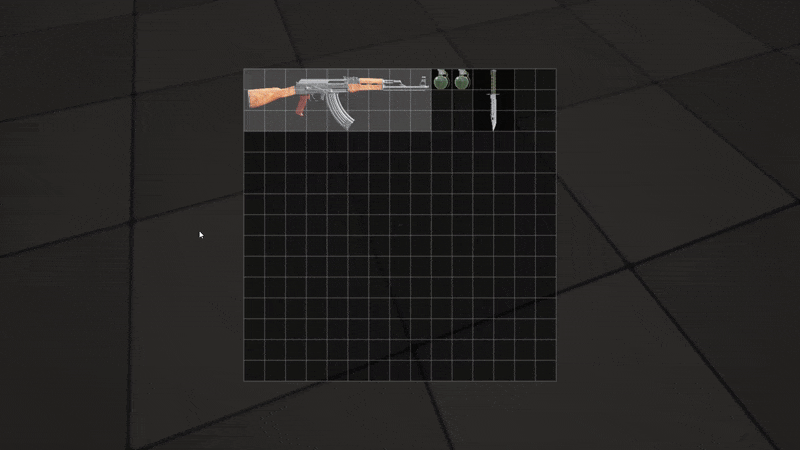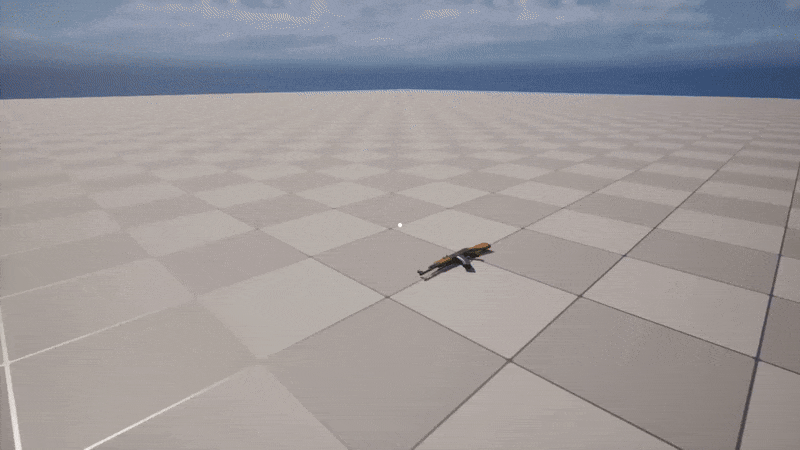< Go Back
A grid based Inventory System written in C++ in Unreal Engine 5. Source code is available on github.
Project Info
- Language: C++
- Engine: Unreal Engine
Implementation
This project was developed for the purpose of learning Unreal Engine. The Pickup system is based on this tutorial and the grid inventory system is developed in C++ using this blueprint based tutorial as a reference.
Weapons models are from this free marketplace asset.
Item Pickup
The pickup system is simple: if a line trace from the player’s crosshair intersects with an actor that implements the required interface, the player can pick up the actor.
FVector TraceStart = CameraComponent->GetComponentLocation();
FVector TraceEnd = TraceStart + CameraComponent->GetForwardVector() * InteractionCheckDistance;
FCollisionQueryParams QueryParms;
QueryParms.AddIgnoredActor(this);
FHitResult HitResult;
if (GetWorld()->LineTraceSingleByChannel(HitResult, TraceStart, TraceEnd, ECollisionChannel::ECC_Visibility, QueryParms))
{
if (HitResult.GetActor()->GetClass()->ImplementsInterface(UInteractionInterface::StaticClass()))
{
if(HitResult.GetActor() != InteractionData.CurrentInteractable)
{
FoundInteractable(HitResult.GetActor());
return;
}
}
}
Inventory Component
Items in the inventory are stored in a
TArray of type UItemBase( ItemBase.h for more info ), pick up of an item in the inventory array is based on item’s dimensions and space in inventory array.
Each tile in the inventory is referenced to each element in the inventory array.
The IsRoomAvailable member function is responsible for checking for enough space in the inventory array which is later called during item pick up and item drag drop.bool UInventoryComponent::IsRoomAvailable(UItemBase* Item, int32 TopLeftIndex)
{
const FTile Tile = IndexToTile(TopLeftIndex);
//horizontal grid
for (int32 j = Tile.X; j < Tile.X + Item->GetDimensions().X; j++)
{
//vertical grid
for (int32 k = Tile.Y; k < Tile.Y + Item->GetDimensions().Y; k++)
{
if (!IsTileValid(FTile(j, k))) return false;
int32 index = TileToIndex(FTile(j, k));
// no room available on the tile
if (InventoryContents[index]) return false;
}
}
return true;
}
for more details on inventory component see InventoryComponent.cpp
Item drag and drop
All drag and drop operations was easily implemented using Unreal’s native virtual functions, such as
NativeOnDragDetected and NativeOnDrop.
The dragged item was passed between widget classes with the help of Unreal’s UDragDropOperation class.Code snippet after detecting the initial item drag with the mouse:
void UInventoryItemSlot::NativeOnDragDetected(const FGeometry& InGeometry, const FPointerEvent& InMouseEvent, UDragDropOperation*& OutOperation)
{
Super::NativeOnDragDetected(InGeometry, InMouseEvent, OutOperation);
UItemDragDropOperation* ItemDragOperation = NewObject<UItemDragDropOperation>();
ItemDragOperation->Payload = Item;
ItemDragOperation->ItemSlot = this;
ItemDragOperation->Pivot = EDragPivot::MouseDown;
BackgroundBorder->SetBrushColor(FLinearColor(0.f, 0.f, 0.f, 0.5f));
Item->OwningInventory->RemoveItem(Item);
//removes the itemslot from inventory panel
RemoveFromParent();
OutOperation = ItemDragOperation;
}
The OutOperation variable will be passed as a parameter to the OnNativeDrop function when a drop is detected on any UserWidget. This variable includes the currently dragged item as a payload.
There are still a lot of features to add and improve existing features, I will keep updating this page as I improve the poject.

